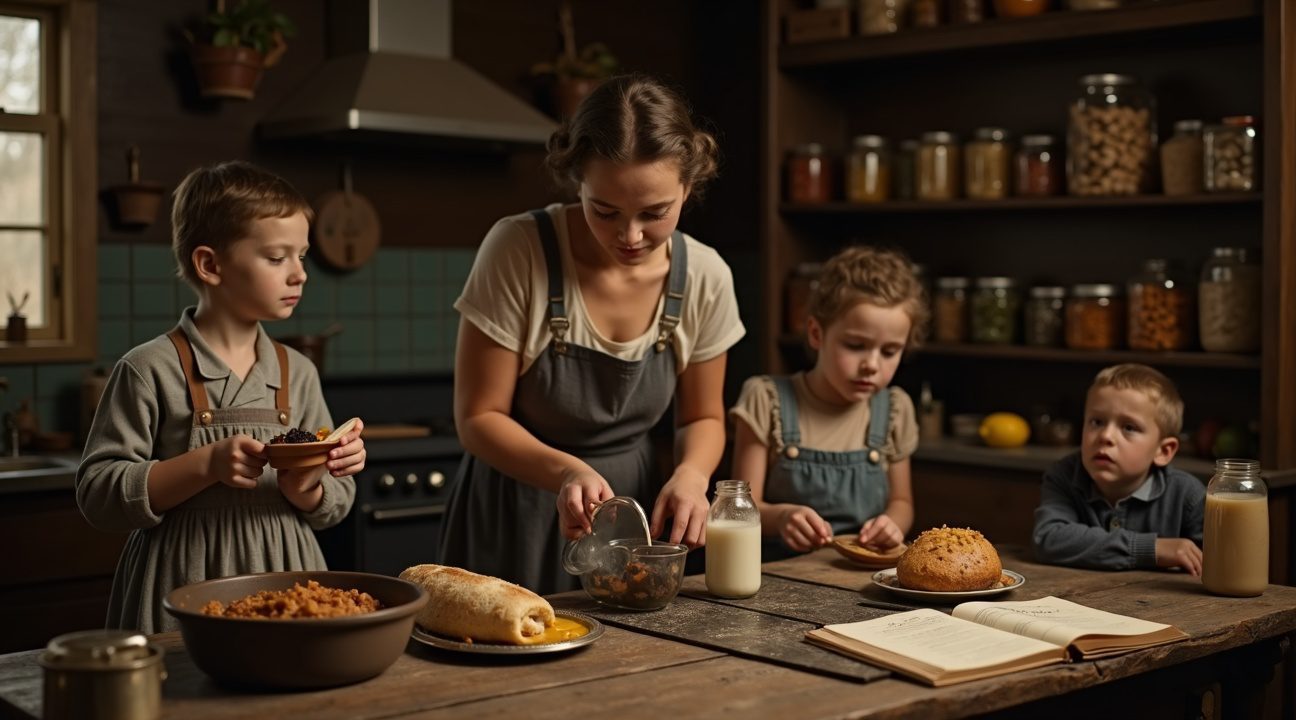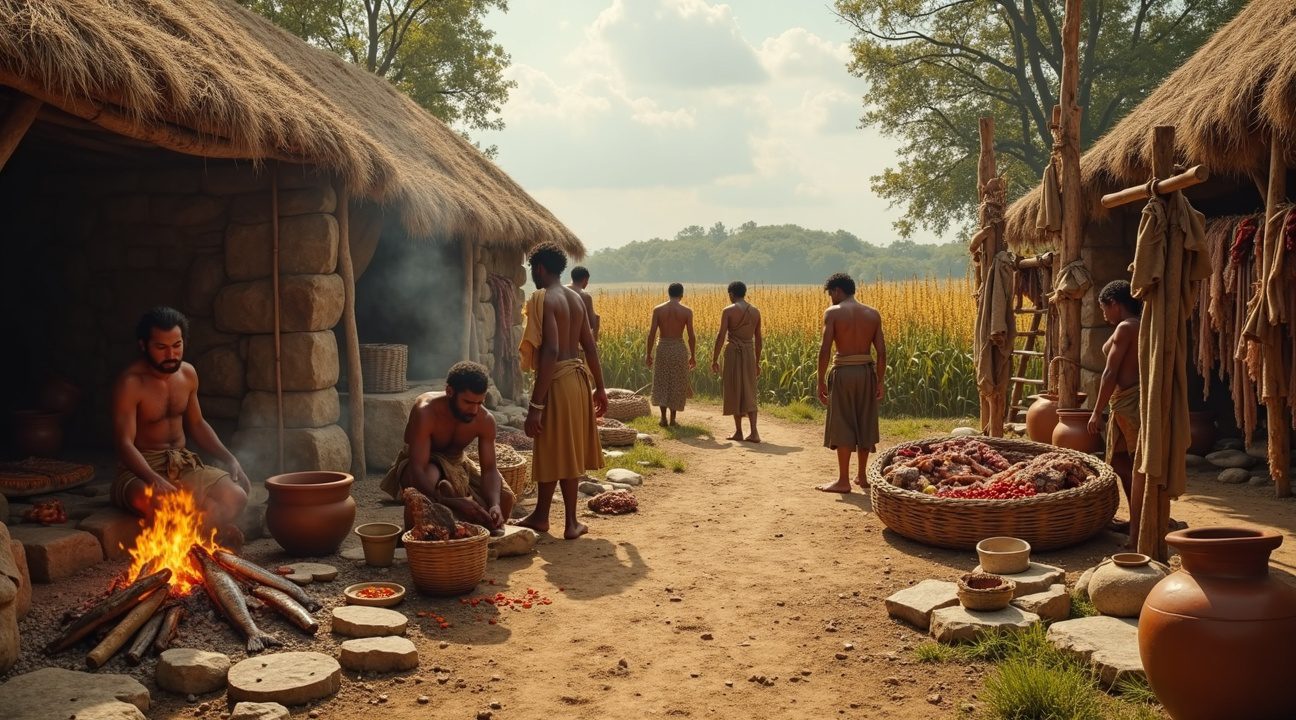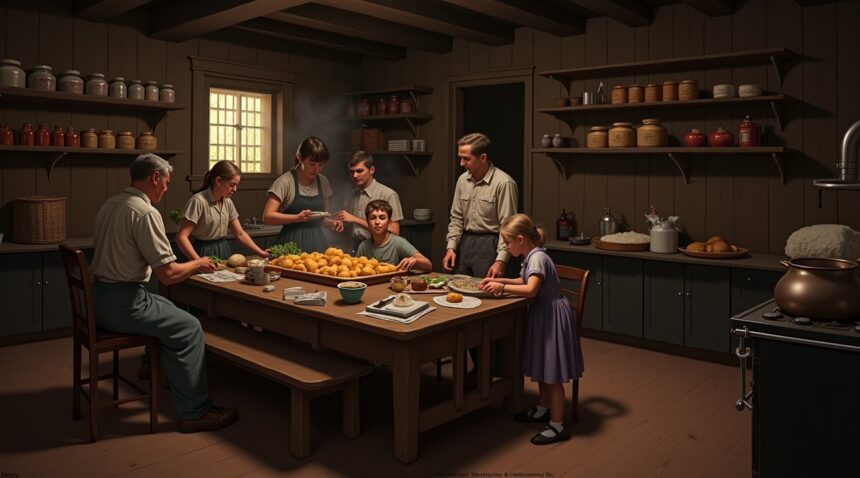Throughout history, cooking has undergone dramatic transformations during periods of hardship, with each crisis sparking innovations that fundamentally changed how people approached food preparation and preservation.
Key Takeaways
- Economic hardship drives culinary innovation – The Great Depression revolutionized American cooking by forcing families to maximize nutrition from minimal ingredients. Creative substitutions and waste-elimination techniques emerged, becoming permanent fixtures in home cooking.
- Preservation methods emerge from survival necessity – Ancient communities developed smoking, salting, and fermentation techniques that prevented food spoilage while enhancing nutritional value. These methods laid the foundation for modern food preservation systems.
- Crisis cooking creates enduring recipes – Depression-era dishes like vinegar pie and wacky cake, as well as medieval fermentation practices, continue to resurface during modern challenges. This proves how resourceful cooking transcends specific eras and remains relevant.
- Community cooperation becomes essential during food scarcity – During historically difficult times, people engaged in collective cooking efforts, shared preservation work, and resource pooling. These actions strengthened social bonds and helped ensure survival through lean periods.
- Strategic ingredient choices maximize survival – Across history, communities in crisis identified staple foods like beans, potatoes, and preserved items that offered high nutrition and satiety at low cost. These patterns still influence sustainable cooking today.
For further reading on the influence of food innovation during tough times, visit Smithsonian Magazine’s retrospective on Great Depression cooking.
When 25% of Americans Lost Their Jobs: How the Great Depression Revolutionized Home Cooking
The Great Depression forever changed American kitchens as unemployment peaked at nearly 25% in 1933. Families across the nation faced unprecedented financial hardship, forcing them to completely rethink their approach to cooking and eating.
Maximizing Resources Through Strategic Ingredients
During this era, households turned to specific staples that delivered maximum nutrition and satiety for minimal cost. These essential ingredients formed the backbone of Depression-era cooking:
- Beans and legumes provided protein at a fraction of meat’s cost
- Potatoes offered filling carbohydrates and essential nutrients
- Canned goods extended shelf life and prevented waste
- Offal and organ meats cost significantly less than prime cuts
- Starchy foods like bread, pasta, and rice created filling meals
Stretching every ingredient became an art form that defined this period. Families watered down milk to make it last longer, transformed stale bread into comforting bread pudding, and repurposed leftover meats into hearty stews and meat pies. Every scrap had value, and nothing edible went to waste.
The concept of nose-to-tail eating gained widespread acceptance during this time. Families consumed every edible part of an animal, from organs to bones for broth. This practice minimized waste while maximizing protein intake. Alternative proteins also emerged as creative solutions—mushrooms frequently replaced meat in recipes, providing umami flavor without the expense.
Creative substitutions became essential kitchen skills. Vinegar replaced expensive lemon juice in recipes, while crackers substituted for apples in pies. These adaptations weren’t just temporary measures; they created entirely new flavor profiles that many families continued using even after prosperity returned.
The Depression birthed iconic recipes that remain recognized today. Depression Cake eliminated expensive eggs and butter, creating a surprisingly moist dessert using vinegar and baking soda. Water Pie used simple pantry ingredients to create a dessert when fresh fruit wasn’t affordable. Jell-O-based desserts stretched ingredients while providing sweetness and color to otherwise plain meals.
This period demonstrated that resourceful cooking could transform limitations into opportunities. The techniques developed during food scarcity created a foundation for American home cooking that emphasized practicality, nutrition, and creativity. These lessons in efficient cooking influenced generations of cooks who learned that remarkable meals could emerge from the simplest ingredients. The Depression’s legacy in American kitchens proves that adversity often sparks the most innovative culinary solutions.

From Open Fires to Earthenware: Ancient Survival Techniques That Changed Everything
I’ve discovered that the transition from nomadic hunting to settled communities marked one of history’s most significant culinary revolutions. Early humans initially relied on simple open-fire roasting, but the introduction of earthenware transformed everything. These ceramic vessels enabled boiling, stewing, and braising—techniques that extracted maximum nutrition from limited ingredients and tough cuts of meat.
Food preservation became a matter of life and death for these early communities. Without refrigeration, civilizations developed ingenious methods to extend food’s shelf life through smoking, salting, air-drying, and sun-drying. The Ancient Egyptians and Phoenicians mastered salting techniques, applying this method to preserve fish, meat, and vegetables for extended periods.
Salt creates an environment hostile to bacteria, effectively preventing spoilage through dehydration and chemical inhibition. This preservation technique, dating back thousands of years, allowed communities to survive harsh winters and failed harvests. Sun-drying proved equally revolutionary, particularly in arid regions where abundant sunshine naturally inhibited bacterial growth by removing moisture from foods.
Strategic Food Systems and Cultural Adaptations
Storage and trade of surplus foods became possible through these preservation methods, fundamentally changing how societies operated. The Aztecs perfected drying techniques for meat and fish, creating stable food supplies that supported their expanding empire. These preserved foods enabled long-distance expeditions and sustained populations through unpredictable seasons.
Native American communities exemplified adaptability through their Three Sisters agricultural system, which combined corn, beans, and squash in symbiotic growing relationships. This innovative approach maximized nutrition while minimizing soil depletion. Each plant provided essential nutrients:
- Corn offered carbohydrates
- Beans contributed protein and nitrogen fixation
- Squash provided vitamins and ground coverage that retained moisture
Wild foraging complemented these agricultural efforts, as communities learned to identify and preserve seasonal plants, nuts, and berries. Early preservation techniques included creating pemmican—a concentrated mixture of dried meat, fat, and berries that provided portable nutrition for hunting expeditions and winter survival.
These ancient techniques laid the groundwork for modern food systems, proving that necessity drives innovation. Every time I consider how cooking with hot sand still captivates people today, I’m reminded of our deep connection to these ancestral methods. Communities that mastered preservation and cooking techniques gained significant advantages in survival, trade, and territorial expansion, establishing patterns that continue influencing culinary traditions across cultures today.

Medieval Famines Sparked the Fermentation Revolution
Food insecurity plagued medieval communities with frightening regularity, forcing people to develop ingenious preservation methods that would fundamentally change how they approached cooking. I’ve discovered that these challenging periods didn’t just test survival instincts—they sparked a fermentation revolution that created some of history’s most enduring culinary traditions.
Pickling emerged as a lifeline during these harsh times, with families submerging vegetables in acidic brine or vinegar to halt spoilage. This technique proved remarkably effective at extending food storage, allowing communities to stretch their harvests through brutal winters and unexpected crop failures. Fermentation took preservation even further, transforming basic ingredients like cabbage into sauerkraut or milk into cheese through controlled bacterial processes.
Essential Preservation Techniques That Changed Everything
- Brining vegetables in salt water created hostile environments for harmful bacteria while encouraging beneficial fermentation
- Vinegar-based pickling provided immediate preservation and added essential nutrients to limited diets
- Cheese-making transformed perishable milk into protein-rich foods that could last months
- Fermented beverages like ale offered safe drinking alternatives when water quality remained questionable
- Community preservation efforts shared risks and resources across entire villages
Fermentation didn’t just preserve food—it actually enhanced nutritional value in ways medieval people couldn’t fully understand but certainly experienced. The process naturally produces B vitamins, vitamin K, and other essential nutrients that often disappeared from stored foods using other methods. Cooking innovations during this period reflected desperate creativity born from necessity.
Community cooperation became essential for surviving lean seasons, with collective cooking efforts and shared preservation work distributing the burden across entire settlements. Communal baking allowed families to pool resources and fuel, while group fermentation projects created larger batches that benefited everyone. These practices established social bonds that extended beyond mere survival, creating traditions that lasted centuries.
The fermentation revolution fundamentally altered medieval diets, turning potential famine into opportunities for nutritional enhancement. What started as desperate preservation tactics evolved into sophisticated culinary techniques that modern chefs still celebrate today. Contemporary chefs continue drawing inspiration from these medieval innovations, proving that necessity truly sparked some of history’s most important cooking breakthroughs.
How Wars and Economic Collapse Drove Kitchen Innovation in the Industrial Age
The Industrial Age transformed the American kitchen through a perfect storm of necessity and innovation. I’ve observed how the convergence of mechanization, economic hardship, and wartime demands created an unprecedented period of culinary evolution that fundamentally changed how families fed themselves.
Revolutionary Preservation Technologies Reshape Home Cooking
Mechanical refrigeration emerged as the cornerstone of this transformation, building upon the foundation laid by ice houses that had served communities for decades. The late 1800s brought Birdseye’s quick freeze process, which revolutionized how households stored meats and vegetables. This technology didn’t just preserve food longer—it changed meal planning entirely, allowing families to buy in bulk and think weeks ahead rather than days.
Home canning became the backbone of food security during this era. By the 1930s, almost every rural home in America maintained some form of food preservation system, with canning and preserving serving as daily chores for millions of families. The process wasn’t just about extending shelf life; it represented economic independence and survival preparedness that proved invaluable during subsequent crises.
Pickling and other preservation methods gained renewed importance as families sought ways to make seasonal abundance last through lean months. These techniques, refined through generations, became standardized and streamlined through industrial-age innovations in equipment and processing methods.
Crisis-Driven Innovation During Wars and Economic Hardship
World War rationing fundamentally altered cooking practices across America. Government campaigns promoted Victory Gardens and bulk preservation as patriotic duties, transforming food production from a purely domestic concern into a national security issue. Families learned to maximize every ingredient, creating new recipes from limited resources and discovering flavor combinations born from necessity rather than choice.
The Great Depression amplified these innovations as economic collapse forced households to stretch every dollar and waste nothing. I’ve found that this period produced some of the most creative solutions in American cooking history, with families developing techniques for using every part of animals and vegetables, creating hearty meals from the simplest ingredients, and perfecting methods for making small amounts of protein feed large families.
Post-war shortages continued to drive inventiveness even after rationing officially ended. Supply chain disruptions meant that ingredients remained unpredictable, pushing home cooks to maintain the adaptive skills they’d developed during wartime. The combination of new preservation technologies and crisis-tested cooking methods created a generation of remarkably resourceful home cooks.
Modern chefs still draw inspiration from these wartime innovations, recognizing how constraint often breeds creativity in professional kitchens. The techniques developed during this era—from creative substitutions to efficient preservation methods—became permanent fixtures in American cooking culture.
These industrial-age innovations didn’t emerge in isolation. Each technology and technique built upon previous knowledge while responding to immediate pressures of war, economic hardship, and changing social structures. The result was a fundamental shift in how Americans approached food procurement, storage, and preparation that established patterns still visible in contemporary home cooking.
The legacy of this period extends beyond specific techniques to encompass an entire philosophy of resourcefulness and adaptability. Modern home cooks continue to benefit from preservation methods perfected during economic collapse, storage solutions developed for wartime rationing, and the creative problem-solving approaches that emerged when families had to make do with less while feeding more people than ever before.
Why Depression-Era Recipes Are Going Viral Again: The Enduring Power of Crisis Cooking
Depression-era cooking techniques have made an unexpected comeback in recent years, proving that resourcefulness never goes out of style. These time-tested methods emerged from necessity but created lasting culinary foundations that continue to influence modern kitchens. The economic hardships of the 1930s forced families to maximize every ingredient, leading to innovations that stretched meals further and eliminated waste entirely.
Food preservation became an art form during this period, with families mastering techniques like canning, pickling, and root cellar storage. Home cooks learned to substitute expensive ingredients with affordable alternatives – using vinegar pie when lemons were unattainable or creating “mock” versions of luxury dishes. These adaptations didn’t just fill stomachs; they established cooking principles that would endure for generations.
The COVID-19 lockdowns of 2020 sparked renewed interest in these forgotten recipes. Social media platforms flooded with videos of home bakers attempting Great Depression classics like wacky cake, which used no eggs, butter, or milk. The viral nature of these recreations demonstrated how crisis cooking resonates across generations, offering both practical solutions and emotional comfort during uncertain times.
Modern sustainable cooking movements mirror many techniques born from Depression-era necessity. Contemporary chefs who practice innovative cooking methods often embrace nose-to-tail cooking, a practice that Depression-era cooks mastered out of pure survival instinct. Community canning circles, bulk cooking strategies, and meal planning all trace their roots back to these lean years.
Legacy Techniques That Shaped Modern Cooking
- Substitution mastery that taught cooks to work with available ingredients rather than following recipes exactly
- Preservation methods that kept food safe without refrigeration, now popular among emergency preparedness enthusiasts
- Leftover transformation techniques that prevented any edible item from reaching the trash
- Community cooking practices that shared resources and knowledge among neighbors
- Seasonal eating patterns that maximized fresh produce availability and flavor
Today’s farm-to-table movement echoes the localized eating patterns that Depression families adopted by necessity. Fresh, seasonal cooking wasn’t a lifestyle choice during the 1930s – it was often the only option available. Modern restaurants that emphasize local sourcing and minimal waste follow principles that struggling families perfected decades ago.
The enduring appeal of crisis cooking lies in its fundamental honesty. These recipes strip away excess and focus on core flavors and nutrition. Professional chefs who’ve mastered complex techniques often return to these simple, efficient methods when seeking authentic flavor combinations. The recent viral resurgence proves that resourcefulness remains relevant, offering both practical skills and a connection to culinary heritage that transcends economic circumstances.
Sources:
All That Cooking – History of Cooking
Farm Fresh Family – History of Food Preservation
The Collector – What Did Americans Eat During the Great Depression?
Eats History – What Did People Eat During the Great Depression?
Culinary 1 Touch Food – Historical Impact of Food Preservation From Survival to Modern Innovations
National Center for Home Food Preservation (NCHFP) – Historical Origins
The Collector – Great Depression Foods: 1930s America
Historic Geneva – Early Food Preservation in the Finger Lakes


